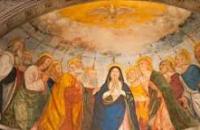
The feast of Pentecost was so named as it occurred fifty days after the Passover. It was a pilgrimage feast, when many Jews came from their homes to the temple. It was an agricultural feast, celebrated to give thanks to God for the harvest but also to acknowledge all that he had done for his chosen people. While Passover commemorated the release of Israel from captivity in Egypt, Pentecost recalled the giving of the Covenant at Sinai. It was appropriate, therefore, that the establishment of the Second Covenant should begin at this time with the birth of the new Israel or church. Many Jews from other countries would have made the pilgrimage to Jerusalem at this time and were therefore able to hear the Good News preached to them.
Luke is the only evangelist who describes the coming of the Holy Spirit. Like the Ascension of the Lord into Heaven, he depicts the coming of the Holy Spirit with symbols: a powerful wind, which created a loud noise through the house, and tongues of fire settling on those assembled in the upper room. That Spirit was to be the guide of the new church, inspiring the apostles to proclaim the teaching of Jesus. It was appropriate too that Mary, mother of the Saviour, would also be present at the birth of his church.
Though the Spirit’s descent is portrayed as a drama, generally his coming is gentle: “Dost refreshing peace bestow” (sequence of Pentecost). The Spirit guides, like Ariadne’s thread through the Labyrinth of Crete, towards the light.